Paper Menu >>
Journal Menu >>
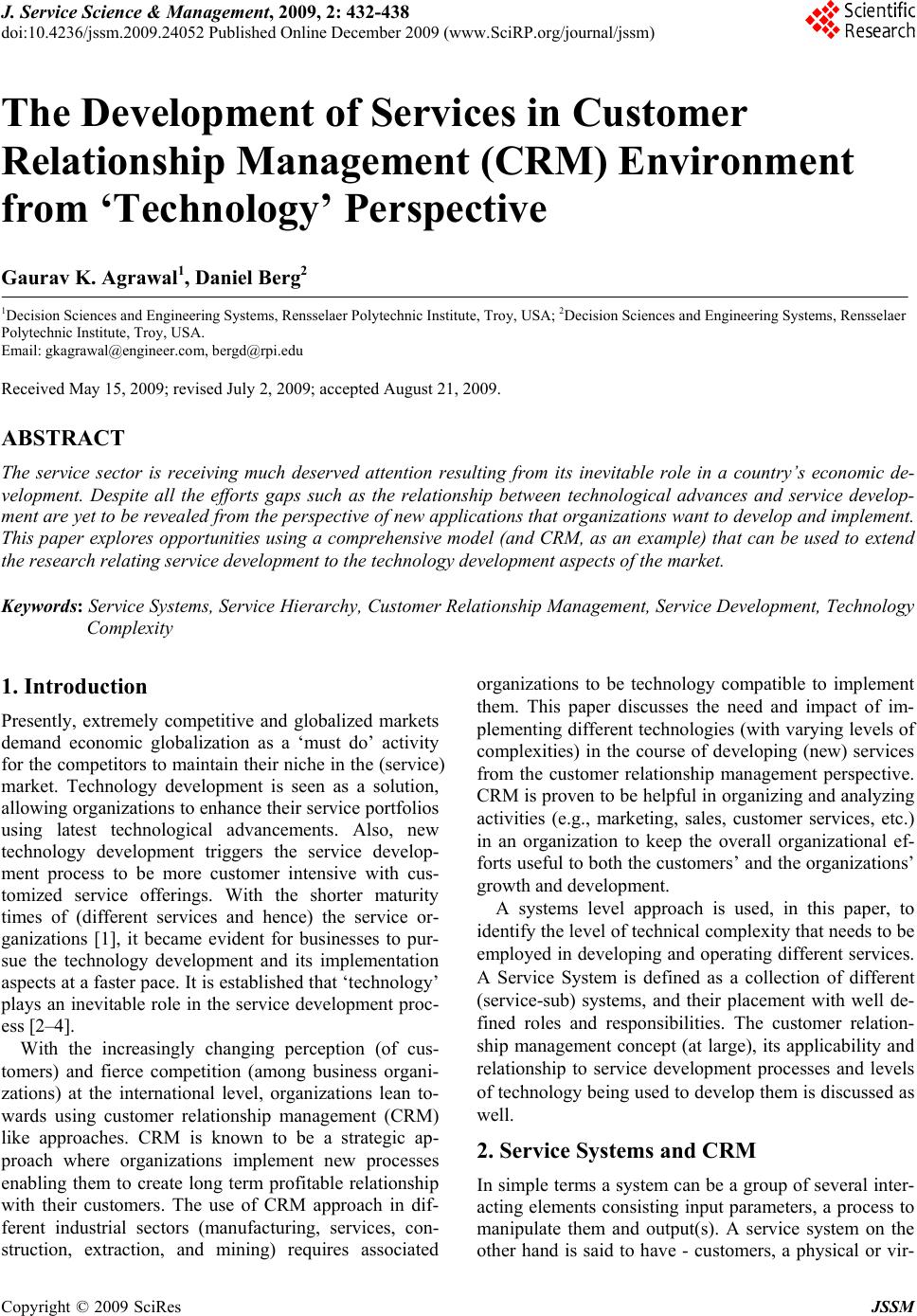 J. Service Science & Management, 2009, 2: 432-438 doi:10.4236/jssm.2009.24052 Published Online December 2009 (www.SciRP.org/journal/jssm) Copyright © 2009 SciRes JSSM The Development of Services in Customer Relationship Management (CRM) Environment from ‘Technology’ Perspective Gaurav K. Agrawal1, Daniel Berg2 1Decision Sciences and Engineering Systems, Rensselaer Polytechnic Institute, Troy, USA; 2Decision Sciences and Engineering Systems, Rensselaer Polytechnic Institute, Troy, USA. Email: gkagrawal@engineer.com, bergd@rpi.edu Received May 15, 2009; revised July 2, 2009; accepted August 21, 2009. ABSTRACT The service sector is receiving much deserved attention resulting from its inevitable role in a country’s economic de- velopment. Despite all the efforts gaps such as the relationship between technological advances and service develop- ment are yet to be revealed from the perspective of new applications that organizations want to develop and implement. This paper explores opportunities u sing a comprehensive model (and CRM, as an example) tha t can be used to extend the research relating service development to the technology development aspects of the market. Keywords: Service Systems, Service Hierarchy, Customer Relationship Management, Service Development, Technology Complexity 1. Introduction Presently, extremely competitive and globalized markets demand economic globalization as a ‘must do’ activity for the competitors to maintain their niche in th e (service) market. Technology development is seen as a solution, allowing organizations to enhance their service portfolios using latest technological advancements. Also, new technology development triggers the service develop- ment process to be more customer intensive with cus- tomized service offerings. With the shorter maturity times of (different services and hence) the service or- ganizations [1], it became evident for businesses to pur- sue the technology development and its implementation aspects at a faster pace. It is established that ‘technology’ plays an inevitable role in the service development proc- ess [2–4]. With the increasingly changing perception (of cus- tomers) and fierce competition (among business organi- zations) at the international level, organizations lean to- wards using customer relationship management (CRM) like approaches. CRM is known to be a strategic ap- proach where organizations implement new processes enabling them to create long term profitable relationship with their customers. The use of CRM approach in dif- ferent industrial sectors (manufacturing, services, con- struction, extraction, and mining) requires associated organizations to be technology compatible to implement them. This paper discusses the need and impact of im- plementing different technologies (with varying levels of complexities) in the course of developing (new) services from the customer relationship management perspective. CRM is proven to be helpful in organizing and analyzing activities (e.g., marketing, sales, customer services, etc.) in an organization to keep the overall organizational ef- forts useful to both the customers’ and the organizations’ growth and development. A systems level approach is used, in this paper, to identify the level of techn ical complexity that n eeds to be employed in developing and operating different services. A Service System is defined as a collection of different (service-sub) systems, and their placement with well de- fined roles and responsibilities. The customer relation- ship management concept (at large), its applicability and relationship to service development processes and levels of technology being used to develop them is discussed as well. 2. Service Systems and CRM In simple terms a system can be a group of several inter- acting elements consisting input parameters, a process to manipulate them and output(s). A service system on the other hand is said to have - customers, a physical or vir- 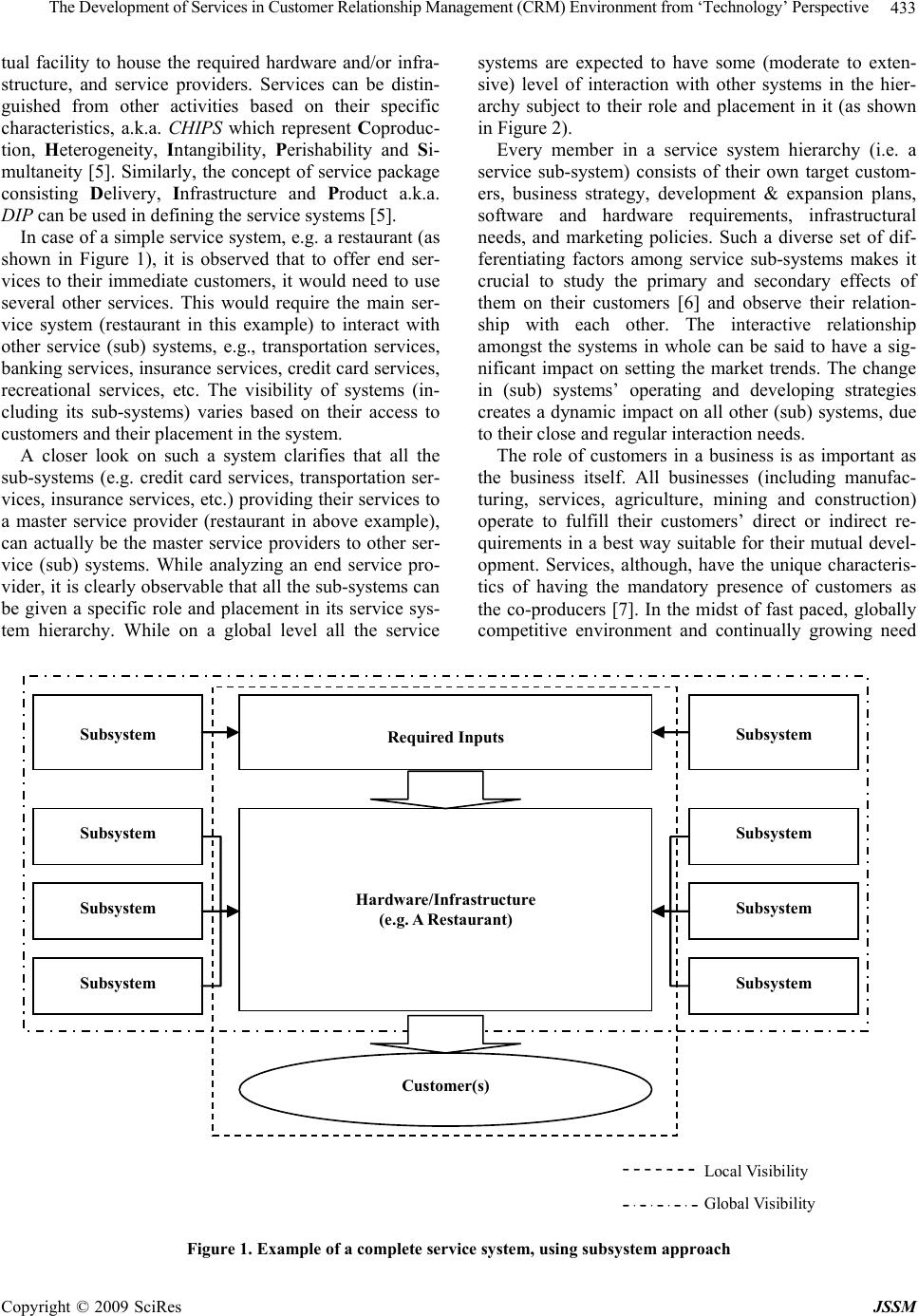 The Development of Services in Customer Relationship Management (CRM) Environment from ‘Technology’ Perspective433 tual facility to house the required hardware and/or infra- structure, and service providers. Services can be distin- guished from other activities based on their specific characteristics, a.k.a. CHIPS which represent Coproduc- tion, Heterogeneity, Intangibility, Perishability and Si- multaneity [5]. Similarly, the concept of service package consisting Delivery, Infrastructure and Product a.k.a. DIP can be used in defining the service systems [5]. In case of a simple service system, e.g. a restaurant (as shown in Figure 1), it is observed that to offer end ser- vices to their immediate customers, it would need to use several other services. This would require the main ser- vice system (restaurant in this example) to interact with other service (sub) systems, e.g., transportation services, banking services, insurance services, credit card services, recreational services, etc. The visibility of systems (in- cluding its sub-systems) varies based on their access to customers and their placement in the system. A closer look on such a system clarifies that all the sub-systems (e.g. credit card services, transportation ser- vices, insurance services, etc.) providing their services to a master service provider (restaurant in above example), can actually be the master service providers to other ser- vice (sub) systems. While analyzing an end service pro- vider, it is clearly observable that all the su b-systems can be given a specific role and placement in its service sys- tem hierarchy. While on a global level all the service systems are expected to have some (moderate to exten- sive) level of interaction with other systems in the hier- archy subject to their role and placement in it (as shown in Figure 2). Every member in a service system hierarchy (i.e. a service sub-system) consists of their own target custom- ers, business strategy, development & expansion plans, software and hardware requirements, infrastructural needs, and marketing policies. Such a diverse set of dif- ferentiating factors among service sub-systems makes it crucial to study the primary and secondary effects of them on their customers [6] and observe their relation- ship with each other. The interactive relationship amongst the systems in whole can be said to have a sig- nificant impact on setting the market trends. The change in (sub) systems’ operating and developing strategies creates a dynamic impact on all other (sub) systems, due to their close and regular interaction needs. The role of customers in a business is as important as the business itself. All businesses (including manufac- turing, services, agriculture, mining and construction) operate to fulfill their customers’ direct or indirect re- quirements in a best way suitable for their mutual devel- opment. Services, although, have the unique characteris- tics of having the mandatory presence of customers as the co-producers [7]. In the midst of fast paced, globally competitive environment and continually growing need Hardware/Infrastructure (e.g. A Restaurant) Customer(s) Required Inputs Subsystem Subsystem Subsystem Subsystem Subsystem Subsystem Subsystem Subsystem Lo cal Visibil ity Global Visibility Figure 1. Example of a complete service system, using subsystem approach Copyright © 2009 SciRes JSSM 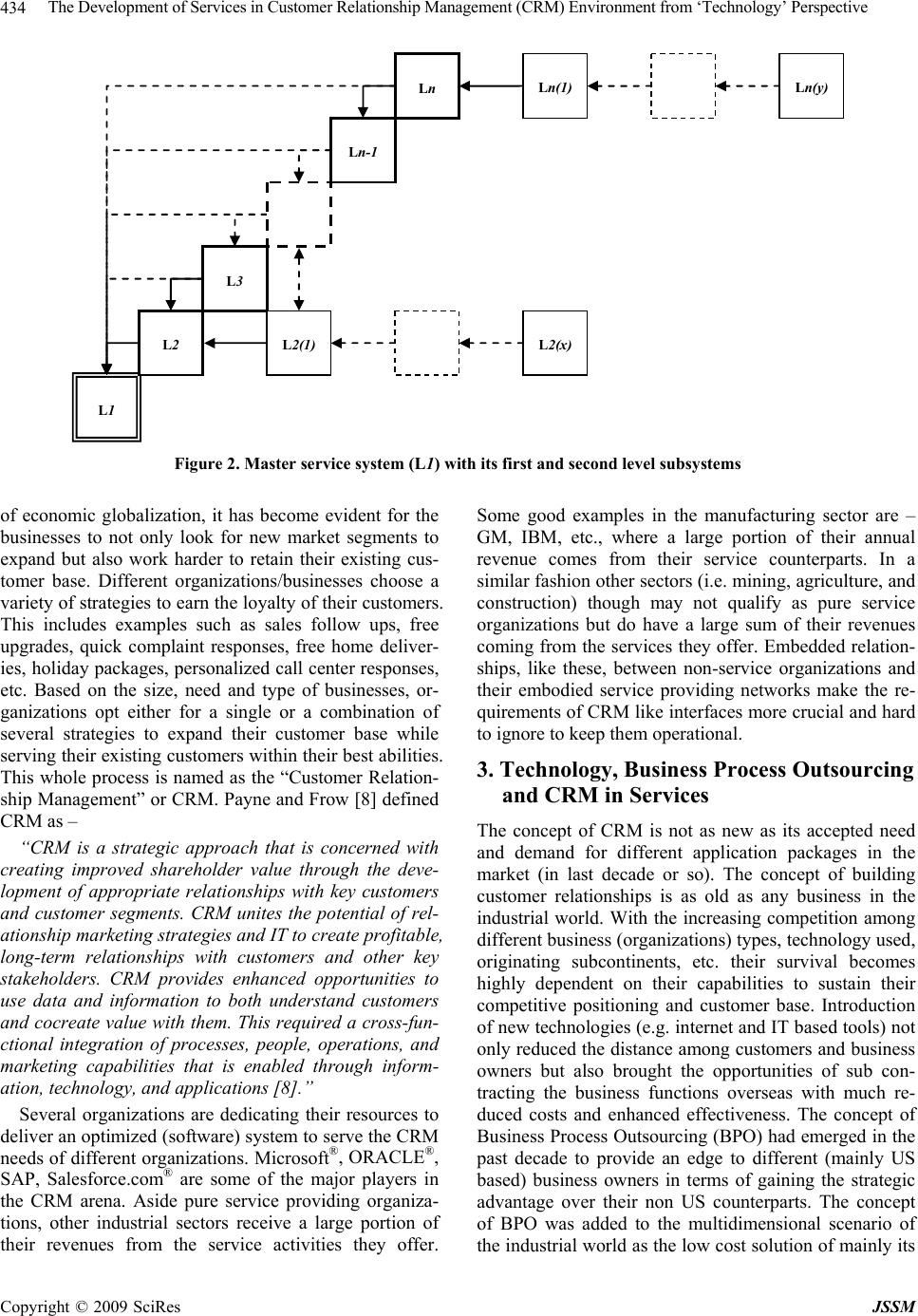 The Development of Services in Customer Relationship Management (CRM) Environment from ‘Technology’ Perspective 434 L1 L2 L3 Ln-1 Ln L2(1) L2(x) Ln(1) Ln(y) Figure 2. Master service system (L1) with its first and second level subsystems of economic globalization, it has become evident for the businesses to not only look for new market segments to expand but also work harder to retain their existing cus- tomer base. Different organizations/businesses choose a variety of strategies to earn the loyalty of their customers. This includes examples such as sales follow ups, free upgrades, quick complaint responses, free home deliver- ies, holiday packages, personalized call center responses, etc. Based on the size, need and type of businesses, or- ganizations opt either for a single or a combination of several strategies to expand their customer base while serving their existing customers within their best ab ilities. This whole process is named as the “Customer Relation- ship Management” or CRM. Payne and Frow [8] defined CRM as – “CRM is a strategic approach that is concerned with creating improved shareholder value through the deve- lopment of appropriate relationships with key customers and customer segments. CRM unites the potential of rel- ationship marketing strategies and IT to create profitable, long-term relationships with customers and other key stakeholders. CRM provides enhanced opportunities to use data and information to both understand customers and cocreate valu e with them. This required a cross-fun- ctional integration of processes, people, operations, and marketing capabilities that is enabled through inform- ation, technology, and app lications [8].” Several organizations are dedicating their resources to deliver an optimized (software) system to serve the CRM needs of different organizations. Microsoft®, ORACLE®, SAP, Salesforce.com® are some of the major players in the CRM arena. Aside pure service providing organiza- tions, other industrial sectors receive a large portion of their revenues from the service activities they offer. Some good examples in the manufacturing sector are – GM, IBM, etc., where a large portion of their annual revenue comes from their service counterparts. In a similar fashion other sectors (i.e. mining, agriculture, and construction) though may not qualify as pure service organizations but do have a large sum of their revenues coming from the services they offer. Embedded relation- ships, like these, between non-service organizations and their embodied service providing networks make the re- quirements of CRM like interfaces more crucial and hard to ignore to keep them operational. 3. Technology, Business Process Outsourcing and CRM in Services The concept of CRM is not as new as its accepted need and demand for different application packages in the market (in last decade or so). The concept of building customer relationships is as old as any business in the industrial world. With the increasing competition among different business (organizations) types, technology used, originating subcontinents, etc. their survival becomes highly dependent on their capabilities to sustain their competitive positioning and customer base. Introduction of new technologies (e.g. internet and IT based tools) not only reduced the distance among customers and business owners but also brought the opportunities of sub con- tracting the business functions overseas with much re- duced costs and enhanced effectiveness. The concept of Business Process Outsourcing (BPO) had emerged in the past decade to provide an edge to different (mainly US based) business owners in terms of gaining the strategic advantage over their non US counterparts. The concept of BPO was added to the multidimensional scenario of the industrial world as the low cost solu tion of mainly its Copyright © 2009 SciRes JSSM 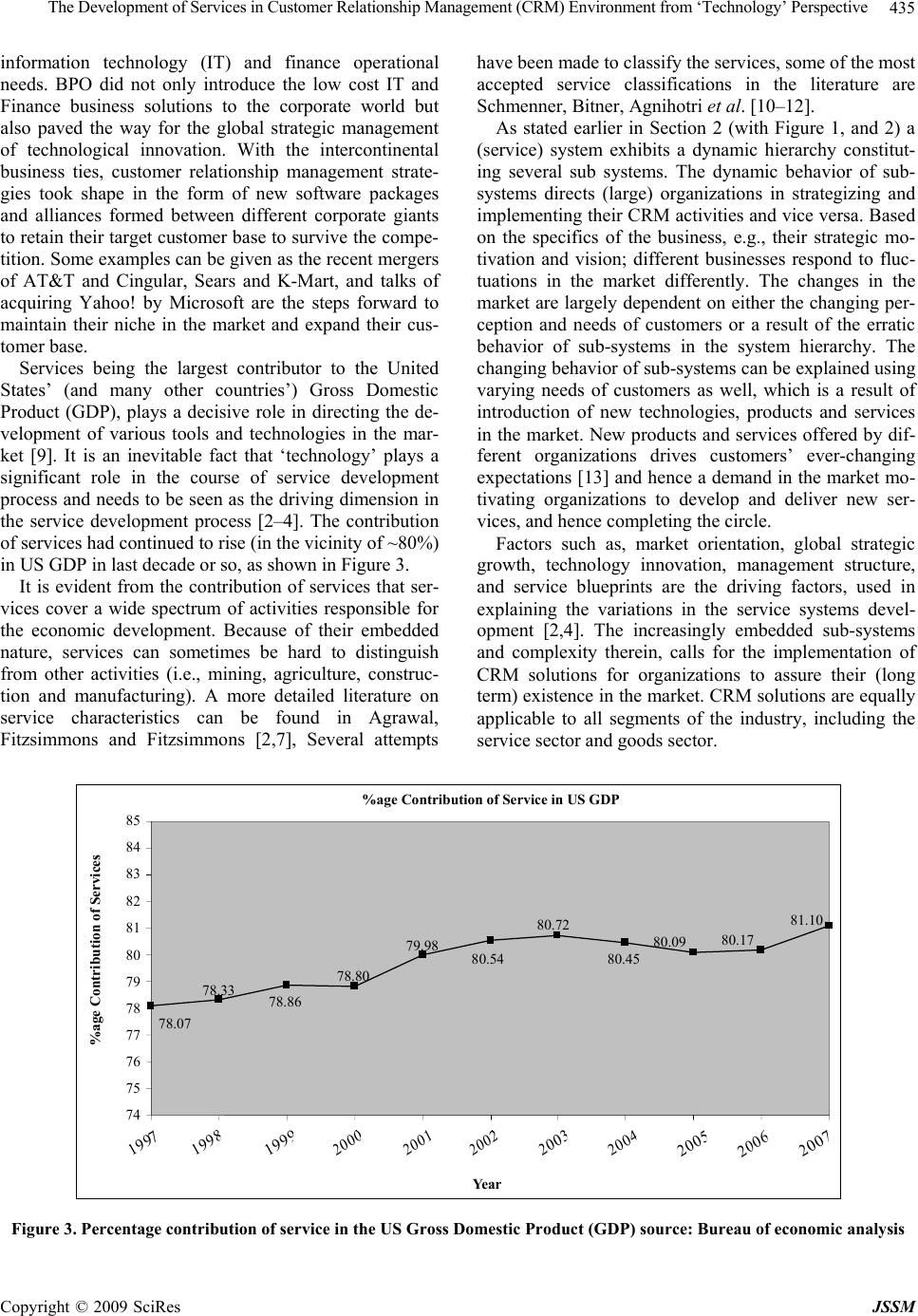 The Development of Services in Customer Relationship Management (CRM) Environment from ‘Technology’ Perspective435 information technology (IT) and finance operational needs. BPO did not only introduce the low cost IT and Finance business solutions to the corporate world but also paved the way for the global strategic management of technological innovation. With the intercontinental business ties, customer relationship management strate- gies took shape in the form of new software packages and alliances formed between different corporate giants to retain their target customer base to survive the compe- tition. Some examples can be given as the recent mergers of AT&T and Cingular, Sears and K-Mart, and talks of acquiring Yahoo! by Microsoft are the steps forward to maintain their niche in the market and expand their cus- tomer base. Services being the largest contributor to the United States’ (and many other countries’) Gross Domestic Product (GDP), plays a decisive role in directing the de- velopment of various tools and technologies in the mar- ket [9]. It is an inevitable fact that ‘technology’ plays a significant role in the course of service development process and needs to be seen as the driving dimension in the service development process [2–4]. The contribution of services had continued to rise (in the vicinity of ~80%) in US GDP in last decade or so, as shown in Figure 3. It is evident from the contribution of services that ser- vices cover a wide spectrum of activities responsible for the economic development. Because of their embedded nature, services can sometimes be hard to distinguish from other activities (i.e., mining, agriculture, construc- tion and manufacturing). A more detailed literature on service characteristics can be found in Agrawal, Fitzsimmons and Fitzsimmons [2,7], Several attempts have been made to classify the services, some of the most accepted service classifications in the literature are Schmenner, Bitner, Agnihotri et al. [10 – 12] . As stated earlier in Section 2 (with Figure 1, and 2) a (service) system exhibits a dynamic hierarchy constitut- ing several sub systems. The dynamic behavior of sub- systems directs (large) organizations in strategizing and implementing their CRM activities and vice versa. Based on the specifics of the business, e.g., their strategic mo- tivation and vision; different businesses respond to fluc- tuations in the market differently. The changes in the market are largely dependent on either the changing per- ception and needs of customers or a result of the erratic behavior of sub-systems in the system hierarchy. The changing behavior of sub-systems can be explained using varying needs of customers as well, which is a result of introduction of new technologies, products and services in the market. New products and services offered by dif- ferent organizations drives customers’ ever-changing expectations [13] and hence a demand in the market mo- tivating organizations to develop and deliver new ser- vices, and hence completing the circle. Factors such as, market orientation, global strategic growth, technology innovation, management structure, and service blueprints are the driving factors, used in explaining the variations in the service systems devel- opment [2,4]. The increasingly embedded sub-systems and complexity therein, calls for the implementation of CRM solutions for organizations to assure their (long term) existence in the market. CRM solutions are equally applicable to all segments of the industry, including the service sector and goods sector. %age Contribution of Service in US GDP 81.10 80.17 78.07 80.09 80.45 80.72 80.54 79.98 78.80 78.33 78.86 74 75 76 77 78 79 80 81 82 83 84 85 Year %age Contribution of Services Figure 3. Percentage contribution of service in the US Gross Domestic Product (GDP) source: Bureau of economic analysis Copyright © 2009 SciRes JSSM 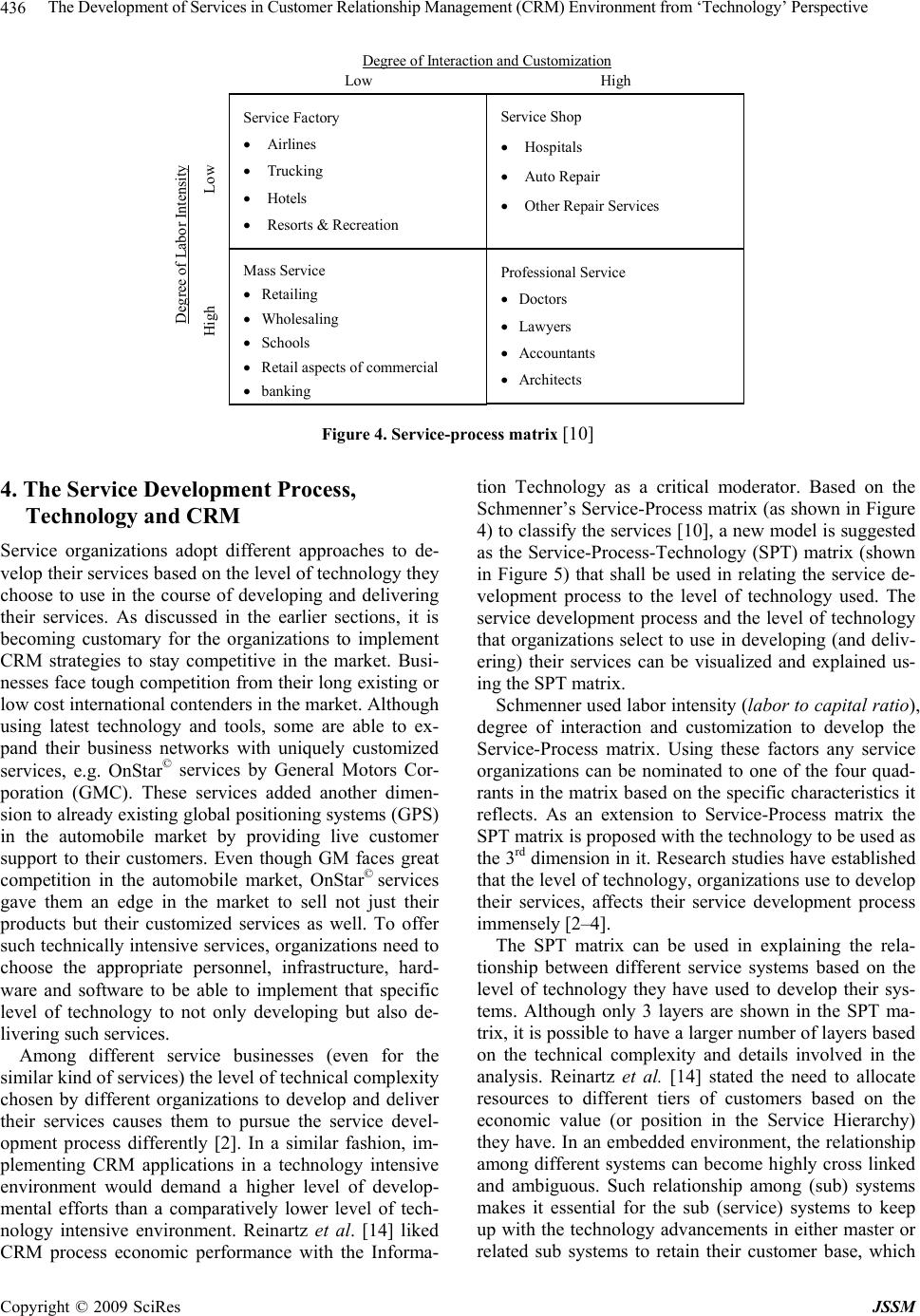 The Development of Services in Customer Relationship Management (CRM) Environment from ‘Technology’ Perspective 436 Service Factory Airlines Trucking Hotels Resorts & Recreation Service Sh op Hospitals Auto R epair Other Repair Servi ces Mass Service Retailing Wholesaling Schools Retail aspe cts of comme rcial banking Professional Service Doctors Lawyers Accountants Architects Deg ree of Interactio n an d Custo m iz a ti o n Degree of Labor Intensity Low High High Low Figure 4. Service-process matrix [10] 4. The Service Development Process, Technology and CRM Service organizations adopt different approaches to de- velop their services b ased on the lev el of technolog y they choose to use in the course of developing and delivering their services. As discussed in the earlier sections, it is becoming customary for the organizations to implement CRM strategies to stay competitive in the market. Busi- nesses face tough competition from their long existing or low cost internation al contend ers in the market. Although using latest technology and tools, some are able to ex- pand their business networks with uniquely customized services, e.g. OnStar© services by General Motors Cor- poration (GMC). These services added another dimen- sion to already existing global positioning systems (GPS) in the automobile market by providing live customer support to their customers. Even though GM faces great competition in the automobile market, OnStar© services gave them an edge in the market to sell not just their products but their customized services as well. To offer such technically intensive services, organizations need to choose the appropriate personnel, infrastructure, hard- ware and software to be able to implement that specific level of technology to not only developing but also de- livering such services. Among different service businesses (even for the similar kind of services) the level of technical complexity chosen by different organizations to develop and deliver their services causes them to pursue the service devel- opment process differently [2]. In a similar fashion, im- plementing CRM applications in a technology intensive environment would demand a higher level of develop- mental efforts than a comparatively lower level of tech- nology intensive environment. Reinartz et al. [14] liked CRM process economic performance with the Informa- tion Technology as a critical moderator. Based on the Schmenner’s Service-Process matrix (as shown in Figure 4) to classify the services [10], a new model is suggested as the Service-Process-Technology (SPT) matrix (shown in Figure 5) that shall be used in relating the service de- velopment process to the level of technology used. The service development process and the level of technology that organizations select to use in developing (and deliv- ering) their services can be visualized and explained us- ing the SPT matrix. Schmenner used labor intensity (labor to capital ratio), degree of interaction and customization to develop the Service-Process matrix. Using these factors any service organizations can be nominated to one of the four quad- rants in the matrix based on the specific characteristics it reflects. As an extension to Service-Process matrix the SPT matrix is proposed with the techno logy to be used as the 3rd dimension in it. Research studies have established that the level of technolog y, organizations use to develop their services, affects their service development process immensely [2–4 ]. The SPT matrix can be used in explaining the rela- tionship between different service systems based on the level of technology they have used to develop their sys- tems. Although only 3 layers are shown in the SPT ma- trix, it is possible to have a larger number of layers based on the technical complexity and details involved in the analysis. Reinartz et al. [14] stated the need to allocate resources to different tiers of customers based on the economic value (or position in the Service Hierarchy) they have. In an embedded environment, the relationship among different systems can become highly cross linked and ambiguous. Such relationship among (sub) systems makes it essential for the sub (service) systems to keep up with the technology advancements in either master or related sub systems to retain their customer base, which Copyright © 2009 SciRes JSSM 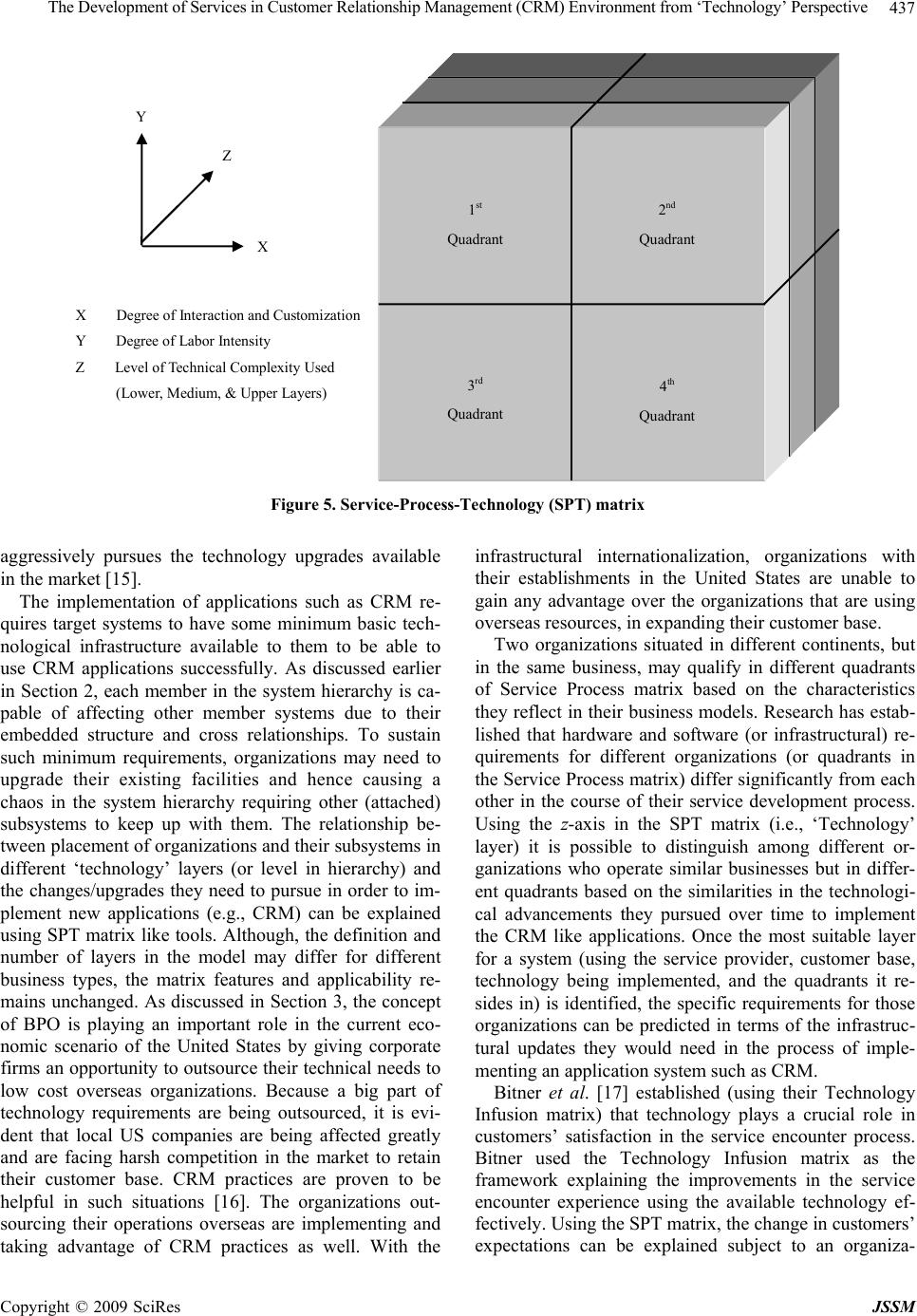 The Development of Services in Customer Relationship Management (CRM) Environment from ‘Technology’ Perspective437 X Y Z X Degree of Interaction and Customization Y Degree of Labor Intensity Z Level of Technical Complexity Used (Lower, Medium, & Upper Layers) 1 st Quadrant 2 nd Quadrant 3 rd Quadrant 4 th Quadrant Figure 5. Service-Process-Technology (SPT) matrix aggressively pursues the technology upgrades available in the market [15]. The implementation of applications such as CRM re- quires target systems to have some minimum basic tech- nological infrastructure available to them to be able to use CRM applications successfully. As discussed earlier in Section 2, each member in the system hierarchy is ca- pable of affecting other member systems due to their embedded structure and cross relationships. To sustain such minimum requirements, organizations may need to upgrade their existing facilities and hence causing a chaos in the system hierarchy requiring other (attached) subsystems to keep up with them. The relationship be- tween placement of organizations and their subsystems in different ‘technology’ layers (or level in hierarchy) and the changes/upgrades they need to pursue in order to im- plement new applications (e.g., CRM) can be explained using SPT matrix like tools. Although, the definition and number of layers in the model may differ for different business types, the matrix features and applicability re- mains unchanged. As discussed in Section 3, the concept of BPO is playing an important role in the current eco- nomic scenario of the United States by giving corporate firms an opportunity to outsource their technical needs to low cost overseas organizations. Because a big part of technology requirements are being outsourced, it is evi- dent that local US companies are being affected greatly and are facing harsh competition in the market to retain their customer base. CRM practices are proven to be helpful in such situations [16]. The organizations out- sourcing their operations overseas are implementing and taking advantage of CRM practices as well. With the infrastructural internationalization, organizations with their establishments in the United States are unable to gain any advantage over the organizations that are using overseas resources, in expanding their customer base. Two organizations situated in different continents, but in the same business, may qualify in different quadrants of Service Process matrix based on the characteristics they reflect in their business models. Research has estab- lished that hardware and software (or infrastructural) re- quirements for different organizations (or quadrants in the Service Process matrix) differ significantly from each other in the course of their service development process. Using the z-axis in the SPT matrix (i.e., ‘Technology’ layer) it is possible to distinguish among different or- ganizations who operate similar businesses but in differ- ent quadrants based on the similarities in the technologi- cal advancements they pursued over time to implement the CRM like applications. Once the most suitable layer for a system (using the service provider, customer base, technology being implemented, and the quadrants it re- sides in) is identified, the specific requirements for those organizations can be predicted in terms of the infrastruc- tural updates they would need in the process of imple- menting an application system such as CRM. Bitner et al. [17] established (using their Technology Infusion matrix) that technology plays a crucial role in customers’ satisfaction in the service encounter process. Bitner used the Technology Infusion matrix as the framework explaining the improvements in the service encounter experience using the available technology ef- fectively. Using the SPT matrix, the change in customers’ expectations can be explained subject to an organiza- Copyright © 2009 SciRes JSSM 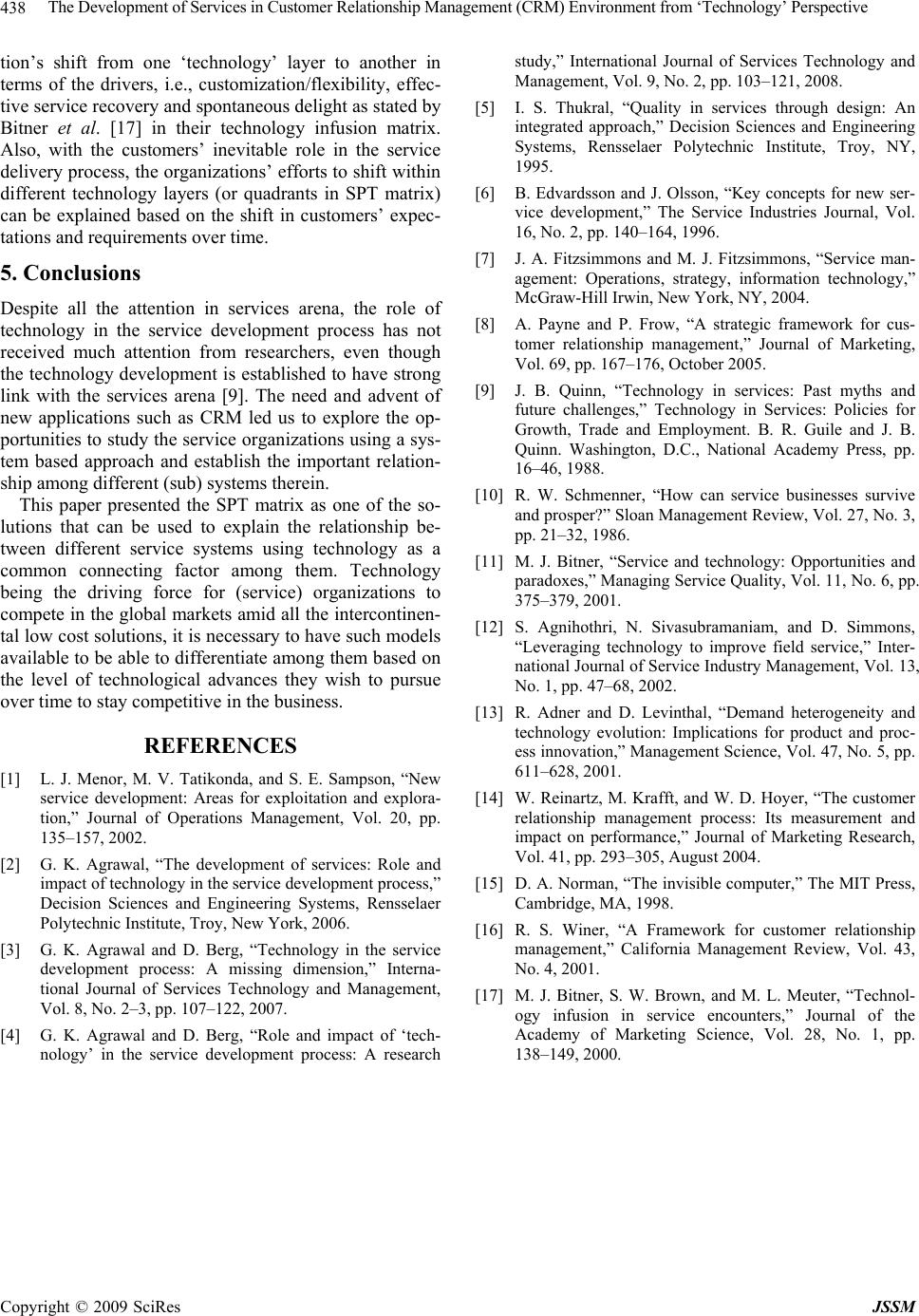 The Development of Services in Customer Relationship Management (CRM) Environment from ‘Technology’ Perspective 438 tion’s shift from one ‘technology’ layer to another in terms of the drivers, i.e., customization/flexibility, effec- tive service recovery and spontaneous delight as stated by Bitner et al. [17] in their technology infusion matrix. Also, with the customers’ inevitable role in the service delivery process, the organizations’ efforts to shift within different technology layers (or quadrants in SPT matrix) can be explained based on the shift in customers’ expec- tations and requirements over time. 5. Conclusions Despite all the attention in services arena, the role of technology in the service development process has not received much attention from researchers, even though the technology development is established to have strong link with the services arena [9]. The need and advent of new applications such as CRM led us to explore the op- portunities to study the service o rganizations using a sys- tem based approach and establish the important relation- ship among different (sub) systems therein. This paper presented the SPT matrix as one of the so- lutions that can be used to explain the relationship be- tween different service systems using technology as a common connecting factor among them. Technology being the driving force for (service) organizations to compete in the global markets amid all the intercontinen- tal low cost solutions, it is necessary to have such models available to be able to differentiate among them based on the level of technological advances they wish to pursue over time to stay competitive in the business. REFERENCES [1] L. J. Menor, M. V. Tatikonda, and S. E. Sampson, “New service development: Areas for exploitation and explora- tion,” Journal of Operations Management, Vol. 20, pp. 135–157, 2002. [2] G. K. Agrawal, “The development of services: Role and impact of technology in the service development process,” Decision Sciences and Engineering Systems, Rensselaer Polytechnic Institute, Troy, New York, 2006. [3] G. K. Agrawal and D. Berg, “Technology in the service development process: A missing dimension,” Interna- tional Journal of Services Technology and Management, Vol. 8, No. 2–3, pp. 107–122, 2007. [4] G. K. Agrawal and D. Berg, “Role and impact of ‘tech- nology’ in the service development process: A research study,” International Journal of Services Technology and Management, Vol. 9, No. 2, pp. 103–121, 2008. [5] I. S. Thukral, “Quality in services through design: An integrated approach,” Decision Sciences and Engineering Systems, Rensselaer Polytechnic Institute, Troy, NY, 1995. [6] B. Edvardsson and J. Olsson, “Key concepts for new ser- vice development,” The Service Industries Journal, Vol. 16, No. 2, pp. 140–164, 1996. [7] J. A. Fitzsimmons and M. J. Fitzsimmons, “Service man- agement: Operations, strategy, information technology,” McGraw-Hill Irwin, New York, NY, 2004. [8] A. Payne and P. Frow, “A strategic framework for cus- tomer relationship management,” Journal of Marketing, Vol. 69, pp. 167–176, October 2005. [9] J. B. Quinn, “Technology in services: Past myths and future challenges,” Technology in Services: Policies for Growth, Trade and Employment. B. R. Guile and J. B. Quinn. Washington, D.C., National Academy Press, pp. 16–46, 1988. [10] R. W. Schmenner, “How can service businesses survive and prosper?” Sloan Management Review, Vol. 27, No. 3, pp. 21–32, 1986. [11] M. J. Bitner, “Service and technology: Opportunities and paradoxes,” Managing Service Quality, Vol. 11, No. 6, pp. 375–379, 2001. [12] S. Agnihothri, N. Sivasubramaniam, and D. Simmons, “Leveraging technology to improve field service,” Inter- national Journal of Service Industry Management, Vol. 13, No. 1, pp. 47–68, 2002. [13] R. Adner and D. Levinthal, “Demand heterogeneity and technology evolution: Implications for product and proc- ess innovation,” Management Science, Vol. 47, No. 5, pp. 611–628, 2001. [14] W. Reinartz, M. Krafft, and W. D. Hoyer, “The customer relationship management process: Its measurement and impact on performance,” Journal of Marketing Research, Vol. 41, pp. 293–305, August 2004. [15] D. A. Norman, “The invisible computer,” The MIT Press, Cambridge, MA, 1998. [16] R. S. Winer, “A Framework for customer relationship management,” California Management Review, Vol. 43, No. 4, 2001. [17] M. J. Bitner, S. W. Brown, and M. L. Meuter, “Technol- ogy infusion in service encounters,” Journal of the Academy of Marketing Science, Vol. 28, No. 1, pp. 138–149, 2000. Copyright © 2009 SciRes JSSM |

